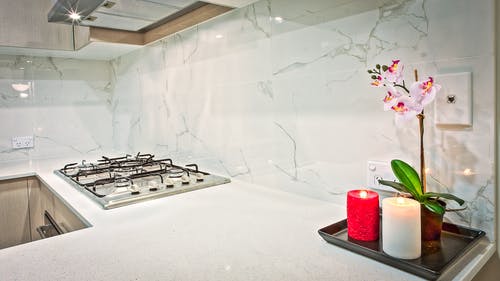Difficulty – Advanced
Duration – A weekend
Whether you’re fitting a completely new kitchen, or looking for an affordable way to update and revamp your old one, fitting new worktops will make a huge difference to the look and feel of your home. There’s a reason that there are plenty of kitchen fitters about – fitting kitchen worktops is a tricky job, which requires a few specialist tools. However, if you’re an experienced DIYer who’s confident in their skills, then there’s no reason why you shouldn’t do it yourself – and save a huge amount of money in the process. Whilst this handy step-by-step guide is focused primarily on fitting laminate kitchen worktops, many of the steps and skills also apply if you’re planning on fitting solid timber.
- Worktops
- Worktop mitre template
- Worktop fixing bolts
- Worktop edging strip
- Worktop contact adhesive
- Colour fill joint sealant
- Jigsaw
- Router
- Trestle
- Clamps
- Tape measure
- File
- Spanners
- Hammer
- Masking tape
- Safety goggles
- Dust mask
Step 1 – First cuts and measure
Once you’ve checked that your kitchen cabinets are secure, in place and level, it’s time to start fitting the worktop. Starting at the left hand side of your kitchen and working clockwise, measure the length for your first piece of worktop. Now, using your jigsaw, cut the first piece of worktop to size, adding at least 70mm (75mm is safer) for overhang, routing and error. Put this piece in place, on top of the cabinets. Repeat the cutting process with the second piece of worktop that will attach to the first piece, again leaving at least 70mm extra.
Step 2 – Male mitre cut
Step 3 – Cutting bolt holes
Step 4 – Female mitre cut
Place your second section back in place on top of the cabinets, with the mitred end sitting on top of the edge of first piece of worktop. Use this to mark the positions of the bolt holes and the mitre on the first piece, to ensure they fit together correctly when the first worktop is cut. Now, take the first worktop, and put it onto your trestle. Place your worktop mitre template over the first worktop, and clamp it in place, before cutting using the router, in the same way you cut the male mitre.
Step 5 – Bolt holes and placing
Once you’ve made the female mitre cut, check your measurements and marks, then cut bolt holes into the first worktop, ensuring that they will line up properly with the second worktop. Now, put the first and second worktops in place, and check they fit together properly, making any small amendments and adjustments as necessary.
Step 6 – Edging
Once the worktops are in place, it’s time to affix the edging strips. Cut a laminate edge slightly longer than you need, then apply your worktop contact adhesive to both the back of the laminate strip, and the edge of the worktops. Wait until the adhesive goes off (it should be touch dry), then attach the edging strip to the kitchen worktops - there should be a slight overhang all the way round. Take your hammer, and lightly tap along the edge to flatten the surface, and remove any lumps and bumps. Now, take your file, and carefully and gently remove the overhanging edge using an upward filing motion to produce a tight, smooth edge.
Step 7 – Connecting and sealing
How we can help
You can lots of high quality tools designed to help you fit your next kitchen worktop over in our DIY tools section – all at fantastic trade prices!
